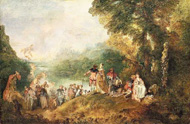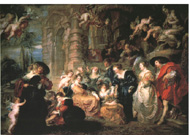Fête galante- elegant entertainment. A term used to describe the subjects of the paintings of Watteau and his followers in which elegant young men gracefully and rather wistfully court fashionably dressed young women in park-like settings.

|

|
| Watteau, Pilgrimage to Cythera, 1717. | Rubens, Garden of Love, c. 1638. |
18th century French art witnesses a debate between artists who advocate the art of Poussin and those that follow Rubens. Through a comparison of these works, document why Watteau can be considered a "Rubeniste." Also note how his work differs from that of Rubens.